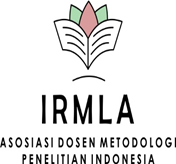Augmented Reality (AR) and Java Application Development for Geometry Learning Medium
Abstract
In the context of mathematics education, specifically in the domain of solid geometry, conventional instructional media, such as textbooks, have been the norm. However, their efficacy is constrained by the reliance on two-dimensional representations, impeding students' comprehension of the concepts conveyed by educators. Many students encounter difficulty in recognizing three-dimensional geometric shapes, resulting in disengagement and a lack of focus. The incorporation of spatial concepts can be significantly enhanced by employing Java-based desktop applications capable of converting tangible objects into three-dimensional graphics. This technological approach offers a more creative means of identifying mathematical spatial formulas. For instance, through the utilization of mobile device cameras, users can practically visualize three-dimensional representations of spatial structures. The presentation of geometric shapes in three dimensions facilitates accelerated learning, allowing students to swiftly comprehend, memorize, and apply formulas accurately to each solid shape. The interactive learning media, based on augmented reality and Java Desktop, attained an expert validation score of 84.1%, indicating a classification of excellence. Furthermore, design experts validated the media with a score of 80%, qualifying it as excellent. Learning media experts provided a validation score of 81.5%, categorizing the augmented reality and Java Desktop-based interactive learning media as excellent. Group testing results indicated a noteworthy 86.7%, falling within the excellent category.
Keywords
Full Text:
PDFReferences
Abdussakir, A. (2009). Pembela jaran Geometri Sesua i Teori Van Hiele. Madrasah Jurnal Pendidikan Dan Pembelajaran Dasar,II(1). Dachi, S. W. (2018). Pengaruh Penggunaan Multimedia Power Pointt Terhadap Hasil Belajar Mahasiswa Prodi Pendidikan Matematika Fkip Umsu. MES: Journal of Mathematics Education and Science,4(1), 101-105. Elsa, H. A., Juandi, D., & Fatimah, S. (2022). Students’ Errors in Solving Solid Geometry Problems. AKSIOMA: Jurnal Program Studi Pendidikan Matematika, 11(3), 2306. https://doi.org/10.24127/ajpm.v11i3.5193 Gianto, E. K. A., Mampouw, H. L., & Setyadi, D. (2018). The Development of MOSIRI (Geometry Transformation Module) for High School Students. Al-Jabar : Jurnal Pendidikan Matematika,9(2), 121–134. https://doi.org/10.24042/ajpm.v9i2.3402 Istikomah, E., Juandi, D., Suryadi, D., Prabawanto, S., Indonesia, U. P., & Riau, U. I. (2022). Dynamic Geometry Software Based Modules: Difficulty Aspects of Studying Geometry at University Level.K R EA N O,13(2), 186–198.
Jupri, A., Gozali, S. M., & Usdiyana, D. (2020). an Analysis of a Geometry Learning Process: the Case of Proving Area Formulas. Prima: Jurnal Pendidikan Matematika, 4(2), 154. https://doi.org/10.31000/prima.v4i2.2619 Parhusip, H. A., Purnomo, H. D., Nugroho, D. B., & Kawuryan, I. S. S. (2021). Learning geometry through surface creation from the hypocycloid curves expansion with derivative operators for ornaments. Desimal: Jurnal Matematika, 4(1), 1–12. https://doi.org/10.24042/djm.v4i1.7385 Pasandaran, R. F., Suciati, I., & Alfisyahra, A. (2021). Exploration of Students’ Understanding of Geometry Concepts. Jurnal Penelitian Ilmu Pendidikan, 14(2), 148–157. https://doi.org/10.21831/jpipfip.v14i2.39562 Rusalam, N. R., Munawar, W., & Hardikusumah, I. (2019). Development of Authentic Assessment in TVET. JRPM (Jurnal Review Pembelajaran Matematika), 7(1), 1–19. https://doi.org/10.2991/ictvet-18.2019.78 Saputro, B. A., Maurizka, H. T., & Purnamasari, V. (2023). Geometry Learning Design for Facilitating Pancasila Student Profile ’ s Critical Reasoning Dimensions of Elementary School Students.Jurnal Ilmiah Pendidikan MIPA,13(2), 137–150. Satria, A., Alvio, R., & Kurniawan, J. (2023). Pengendali Robot Pebisnis Menggunakan Teknologi Virtual Realty. Jurnal Teknik Mesin, Industri, Elektro Dan Informatika (JTMEI),2(4), 146–155. Satria, A., Ramadhani, F., & Salamah, S. (2023). Pengembangan Bahan Ajar Digital Flipbook Dalam Meningkatkan Kompetensi Guru TK di TK Citra Indonesia. Jurnal Pengabdian Pada Masyarakat Indonesia, 2(5), 58–65. https://jurnal.ugp.ac.id/index.php/jppmi/article/view/880 Wulandari, C. (2017). Menanamkan Konsep Bentuk (Bangun Datar). Jurnal Pengabdian Masyarakat Ipteks,3(Juni), 1–8.
DOI: https://doi.org/10.30596/jmes.v5i1.18575
Refbacks
- There are currently no refbacks.
This work is licensed under a Creative Commons Attribution-NonCommercial-ShareAlike 4.0 International License.


.png)



